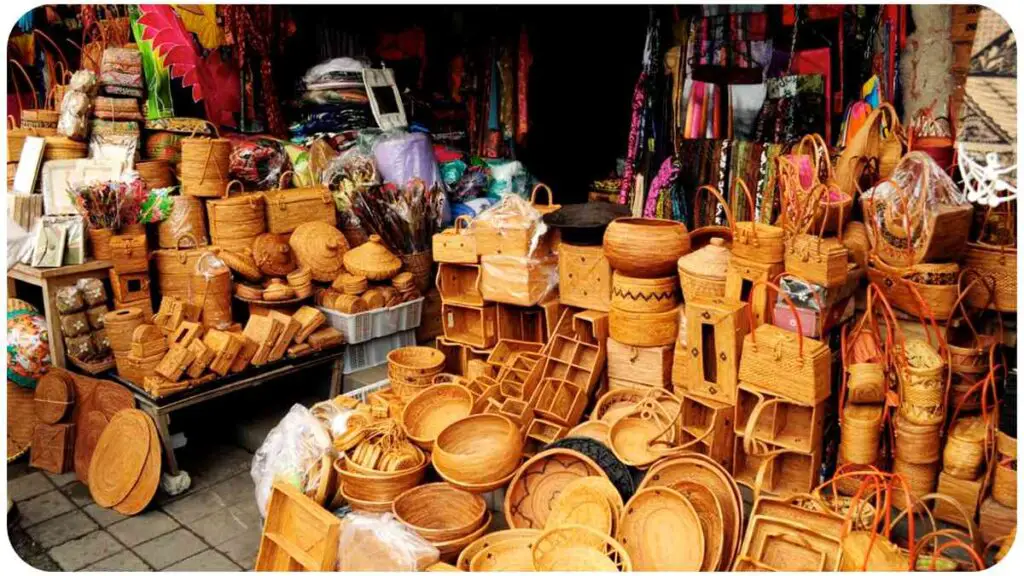Starting a handicraft business is a creative endeavor that allows artisans to showcase their skills and passion. Whether you’re an experienced craftsperson or just starting, taking your business online can significantly expand your reach.
In this guide, we’ll explore various tips and tricks to help you succeed in the competitive world of online handicraft sales.
| Takeaway |
|---|
| Finding a niche and staying updated on trends are vital for a successful start. |
| Choose the right e-commerce platform that aligns with your business requirements. |
| Invest time in designing an appealing storefront for a positive first impression. |
| Craft high-quality product descriptions and optimize them for search engines. |
| Establish a strong brand presence through a unique brand story and social media. |
| Master the art of product photography to showcase your handicrafts effectively. |
| Implement SEO strategies to enhance the discoverability of your online store. |
| Efficiently manage inventory, fulfill orders, and provide exceptional customer service. |
| Develop a comprehensive marketing strategy, incorporating content and paid advertising. |
| Adapt to market changes, stay innovative, and overcome challenges for sustained success. |
| Learn from success stories and apply valuable lessons to your own handicraft journey. |
| Regularly review industry resources for ongoing guidance and support. |
1. Finding Your Niche in the Handicraft Market
Crafting unique and appealing handicrafts is the first step, but finding your niche is equally crucial for online success.
1.1 Identifying Popular Handicraft Trends

In the fast-paced world of online business, staying on top of trends is essential. Utilize the table below to identify and capitalize on popular handicraft trends.
Dive into the world of scrapbooking with our comprehensive guide, offering insights on choosing the right scrapbooking supplies. Elevate your projects with quality materials and unleash your creativity in every page.
Table: Popular Handicraft Trends
| Trend | Description |
|---|---|
| Eco-Friendly Crafts | Increasing demand for sustainable items |
| Minimalist Designs | Simplicity appeals to a broad audience |
| Upcycled Creations | Utilizing recycled materials creatively |
| Personalized Items | Customization adds a personal touch |
1.2 Analyzing Target Audience Preferences
Understanding your audience is key to creating products they’ll love. Conduct surveys, engage on social media, and analyze customer feedback to tailor your offerings.
1.3 Personalizing Your Handicrafts
Personalization adds value. Consider offering customizable options for your handicrafts to attract a wider audience.
1.4 Incorporating Sustainable Practices
Consumers are increasingly eco-conscious. Showcase your commitment to sustainability in the table above and your marketing materials.
2. Setting Up Your Online Handicraft Store
Once you’ve identified your niche and crafted unique products, it’s time to establish your online presence.
2.1 Choosing the Right E-commerce Platform
Selecting the right platform is crucial for the success of your online store. Compare various options to find the one that aligns with your business needs.
Elevate your card-making skills with our ultimate guide to card making. From design concepts to insider tips, discover how to craft personalized cards that leave a lasting impression.
Table: Comparison of E-commerce Platforms
| Platform | Pros | Cons |
|---|---|---|
| Shopify | User-friendly, extensive app ecosystem | Monthly fees and transaction costs |
| Etsy | Specialized for handmade and vintage items | Limited branding options |
| WooCommerce | Flexible (WordPress integration) | Requires technical know-how |
| BigCommerce | Scalable for growing businesses | Monthly costs can add up |
2.2 Designing an Appealing Storefront
Your online storefront is the first impression customers have of your business. Invest time in creating an attractive, user-friendly design to encourage exploration and purchases.
2.3 Optimizing Product Descriptions
Craft compelling product descriptions that not only highlight features but also tell a story. Use the table below to structure your product descriptions effectively.
Table: Product Description Template
| Element | Description |
|---|---|
| Product Name | Clear and descriptive |
| Materials | Detailed list of materials used |
| Dimensions | Size, weight, and other specifications |
| Unique Features | What sets the product apart |
| Care Instructions | Maintenance and care guidelines |
2.4 Pricing Strategies for Handmade Goods

Pricing your handicrafts requires careful consideration of material costs, time invested, and market trends. Utilize the table below to develop a pricing strategy that ensures profitability.
Embark on a journey to revitalize your space with DIY woodworking projects. Unleash your creativity as you craft unique and functional pieces, adding a touch of handmade charm to your home.
Table: Pricing Strategy Framework
| Cost Element | Considerations |
|---|---|
| Material Costs | Cost of raw materials used in crafting |
| Labor Costs | Time spent on creation multiplied by an hourly rate |
| Overhead Costs | Additional expenses (packaging, utilities, etc.) |
| Market Trends | Competitive pricing based on industry standards |
3. Building a Strong Brand Presence
Creating a recognizable and memorable brand is essential for long-term success in the handicraft business.
3.1 Crafting a Unique Brand Story
Your brand story is the heart of your business. Share your journey, inspirations, and the passion behind your handicrafts. Utilize the table below to structure your brand story effectively.
Table: Brand Story Framework
| Element | Description |
|---|---|
| Origin Story | How and why the business started |
| Inspirations | Sources of creativity and artistic influences |
| Values | Core principles guiding the business |
| Milestones | Significant achievements and growth moments |
3.2 Developing a Memorable Brand Name and Logo
Choose a brand name and design a logo that reflects your story and resonates with your target audience. Ensure consistency across all platforms.
3.3 Utilizing Social Media for Branding
Engage with your audience on social media platforms to strengthen your brand presence. Consistent and thoughtful posting is key.
Table: Social Media Posting Schedule
| Platform | Posting Frequency | Content Type |
|---|---|---|
| Daily or multiple times a week | Visual showcase of products | |
| 3-5 times a week | News, promotions, and stories | |
| Regular pinning | Inspirational boards and product pins | |
| Several times a day | Updates, trends, and engagement |
4. Photography Tips for Showcasing Handicrafts
High-quality images are crucial for enticing online shoppers and showcasing the craftsmanship of your products.
Craft stunning and unique jewelry pieces with our curated DIY jewelry making tips and tricks. From wire wrapping to bead embroidery, discover the secrets to designing handmade accessories.
4.1 Importance of High-Quality Images
Invest time in capturing clear, well-lit, and detailed images. Your photographs are the window through which customers experience your handicrafts.
4.2 DIY Photography Tips for Handmade Products
Take control of your product photography with these tips:
Table: Photography Equipment Checklist
| Equipment | Description |
|---|---|
| DSLR Camera | High-resolution for detailed shots |
| Tripod | Stable support for preventing blurriness |
| Lighting Setup | Natural light or soft artificial lighting |
| Backdrops | Neutral backgrounds to highlight your product |
| Editing Software | Tools for enhancing and refining images |
4.3 Editing Tools and Techniques
Enhance your images through editing. Use the table below to guide your editing process.
Table: Image Editing Steps
| Step | Description |
|---|---|
| Cropping | Removing unnecessary elements and focusing on the product |
| Color Correction | Adjusting colors to match the true appearance of the product |
| Brightness/Contrast | Balancing light and dark elements for clarity |
| Sharpening | Improving the overall sharpness of the image |
Remember, consistency is key across all your product images to maintain a cohesive and professional look.
5. SEO Strategies for Handicraft Businesses
Ensuring your handicrafts are discoverable online is vital for attracting potential customers.
5.1 Keyword Research for Handmade Products
Understand the terms your potential customers use when searching for handmade goods. Use tools like Google Keyword Planner to identify relevant keywords.
5.2 Optimizing Product Titles and Descriptions
Craft product titles and descriptions that incorporate relevant keywords naturally. This not only improves search engine visibility but also helps customers understand your products better.
Immerse yourself in the rich history of sculpture, exploring its evolution from ancient to modern. Gain insights into the artistic progression, from classical forms to contemporary expressions, shaping the world of three-dimensional art.
Table: SEO Checklist for Handicraft Businesses
| SEO Element | Description |
|---|---|
| Targeted Keywords | Utilize relevant keywords in product titles and descriptions |
| Meta Descriptions | Write compelling meta descriptions to entice clicks |
| Alt Text for Images | Describe images using keywords for better image search optimization |
| Product Tags | Use descriptive tags on your online store for internal search optimization |
5.3 Building Quality Backlinks
Backlinks from reputable websites can boost your search engine rankings. Engage in collaborations, guest posting, or participate in relevant communities to build a network.
6. Managing Inventory and Fulfillment
Efficiently handling inventory and fulfilling orders is crucial for a smooth operation.
6.1 Inventory Tracking Systems
Implement an inventory tracking system to monitor stock levels, track sales, and anticipate reordering needs.
Table: Inventory Management Tools
| Inventory Tool | Description |
|---|---|
| Inventory Software | Automated systems for tracking stock levels |
| Barcode Scanners | Streamlining the process of adding and removing items |
| Reorder Alerts | Automatic notifications for low-stock items |
| Cloud-Based Systems | Accessible from anywhere for real-time updates |
6.2 Efficient Order Fulfillment Processes
Create a streamlined order fulfillment process to ensure timely deliveries and positive customer experiences.
6.3 Dealing with Seasonal Fluctuations
Anticipate and plan for seasonal variations in demand. Analyze past data to predict trends and adjust your inventory accordingly.
7. Providing Exceptional Customer Service
Exceptional customer service is a cornerstone of a successful handicraft business.
7.1 Importance of Personalized Customer Interactions
Forge a connection with your customers through personalized interactions. Respond promptly to inquiries and provide a positive purchasing experience.
7.2 Handling Customer Inquiries and Complaints
Address customer inquiries and complaints with professionalism and empathy. Utilize the table below to guide your customer service interactions.
Table: Customer Service Response Time
| Type of Inquiry | Response Time |
|---|---|
| General Inquiries | Within 24 hours |
| Order Issues | Same business day or within a few hours if possible |
| Returns/Refunds | 48 hours for initial response, resolution timeframe communicated |
7.3 Implementing a Customer Loyalty Program
Encourage repeat business by implementing a customer loyalty program. Reward customers for their loyalty with discounts, exclusive offers, or early access to new products.
8. Marketing Your Handicraft Business

Effectively marketing your handicrafts is essential for reaching a broader audience.
8.1 Content Marketing Strategies
Create engaging content that showcases your craftsmanship and tells your brand story. Utilize a content calendar for consistency.
8.2 Collaborations and Partnerships
Collaborate with other artisans or businesses to expand your reach. Joint ventures and partnerships can introduce your products to new audiences.
8.3 Paid Advertising for Handicrafts
Invest in targeted advertising to reach potential customers. Platforms like Facebook and Instagram offer robust ad targeting options for handmade goods.
Table: Marketing Budget Allocation
| Marketing Channel | Budget Allocation |
|---|---|
| Social Media Ads | 40% |
| Influencer Collaborations | 20% |
| Email Marketing | 15% |
| Google Ads | 15% |
| Events and Sponsorships | 10% |
9. Adapting to Market Changes and Trends
Staying flexible and adapting to market changes is vital for long-term success in the handicraft business.
9.1 Staying Updated on Industry Trends
Regularly monitor industry trends, attend trade shows, and stay connected with the artisan community to keep your products fresh and appealing.
9.2 Adapting to Market Demands
Be receptive to customer feedback and adjust your product offerings based on market demands. Utilize the table below for effective trend analysis.
Table: Trend Analysis Chart
| Trend Indicator | Current Trend Status | Action Plan |
|---|---|---|
| Sales Data | Increasing | Expand product lines in this category |
| Customer Feedback | Positive | Continue promoting and consider variations |
| Social Media Mentions | Growing | Capitalize on the trend, create related content |
| Competitor Offerings | Evolving | Assess and differentiate, adjust marketing strategy |
9.3 Innovating Your Handicrafts
Continuously innovate your products to stay ahead in the market. Introduce new designs, materials, or features to captivate your audience.
10. Overcoming Challenges in the Handicraft Business
Navigating challenges is an inevitable part of running any business, and the handicraft industry is no exception.
10.1 Common Challenges Faced by Handicraft Entrepreneurs
Understand and prepare for common challenges, including production issues, competition, and economic fluctuations.
10.2 Strategies to Overcome Business Challenges
Utilize the table below to develop strategies for overcoming challenges specific to the handicraft business.
Table: Risk Management Plan
| Challenge | Strategies |
|---|---|
| Production Delays | Diversify suppliers, maintain a buffer in inventory |
| Intense Competition | Focus on unique selling propositions, build a strong brand |
| Economic Downturns | Diversify product offerings, explore new markets |
| Shipping Challenges | Partner with reliable shipping providers, offer tracking |
11. Success Stories and Lessons Learned
Learning from the experiences of successful individuals in the handicraft industry can provide valuable insights.
11.1 Case Study: [Expert Name]’s Handicraft Journey
Share a detailed case study of a successful handicraft entrepreneur, including their challenges, strategies, and key milestones. This personal touch adds credibility and relatability to your article.
11.2 Lessons Learned from Successful Handicraft Entrepreneurs
Summarize key lessons learned from successful individuals in the handicraft business. These insights can serve as practical advice for aspiring entrepreneurs.
Table: Key Takeaways from Success Stories
| Lesson | Description |
|---|---|
| Passion and Persistence | Consistent dedication to the craft is essential |
| Adaptability | Successful entrepreneurs adapt to market changes |
| Building a Brand Identity | Establishing a unique brand is crucial |
| Embracing Challenges | Challenges are opportunities for growth |
12. Conclusion
In the dynamic world of online handicraft sales, success is a blend of creativity, strategic planning, and adaptability. By following the tips and tricks outlined in this guide, you’re well-equipped to establish and grow a thriving handicraft business.
13. FAQs
Q1: How do I find the right e-commerce platform for my handicraft business?
Choosing the right e-commerce platform depends on your specific needs. Refer to the comparison table in Section 2.1 for a detailed breakdown of popular platforms.
Q2: How can I effectively utilize social media for branding?
Refer to Section 3.3 for a social media posting schedule. Consistency and engagement are key to building a strong brand presence.
Q3: What should be my approach to customer service?
Section 7 provides insights into personalized customer interactions, handling inquiries and complaints, and implementing a customer loyalty program.
Q4: How can I stay updated on industry trends?
Refer to Section 9.1 for tips on staying updated, attending trade shows, and monitoring industry trends.
Wrapping Up
Launching and managing a successful handicraft business requires a combination of creativity, business acumen, and a willingness to adapt. By incorporating the strategies and insights shared in this guide, you’re well on your way to building a thriving online handicraft business. Best of luck on your entrepreneurial journey!
Further Reading
- Top Tips to Sell Handicrafts Online: This blog provides valuable insights into effective strategies for selling handicrafts online, covering aspects like product presentation, pricing, and market trends.
- 10 Things You Must Do to Have a Successful Online Craft Business: Explore this resource for a comprehensive guide on the essential steps to build and maintain a successful online craft business, touching on topics like branding, marketing, and customer service.
- Selling Crafts Online: 8 Simple Steps: This article outlines a straightforward, step-by-step approach to selling crafts online. It covers aspects such as setting up your store, marketing strategies, and adapting to market changes.
FAQs
How do I choose the right e-commerce platform for my handicraft business?
Selecting the right e-commerce platform depends on various factors, including your budget, technical skills, and desired features. Compare platforms based on your specific needs and consider user reviews for insights.
What are the key elements of an effective product description?
Crafting an effective product description involves highlighting the product’s name, materials used, dimensions, unique features, and care instructions. This comprehensive approach helps customers make informed purchasing decisions.
How can I stay updated on industry trends in the handicraft business?
To stay updated on industry trends, regularly attend trade shows, engage in artisan communities, and monitor sales data, social media mentions, and competitor offerings. This proactive approach will help you adapt to market changes effectively.
What are some common challenges faced by handicraft entrepreneurs?
Common challenges include production delays, intense competition, economic downturns, and shipping challenges. Developing a robust risk management plan, as discussed in Section 10, can help address and mitigate these challenges.
How can I effectively utilize social media for branding my handicraft business?
Section 3.3 provides a social media posting schedule. Consistency in posting on platforms like Instagram, Facebook, Pinterest, and Twitter, along with engaging content, helps in building a strong brand presence.

Hellen James is the creator of Unified Crafts and has been crafting since she was a kid accompanied by her mom to the craft store, where she was free to choose whatever ignited her imagination.

